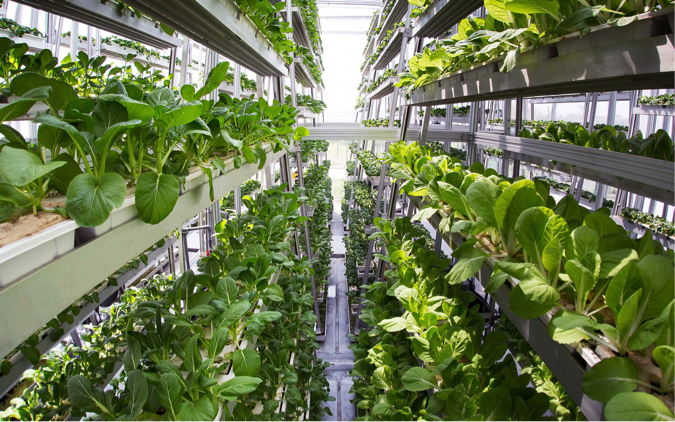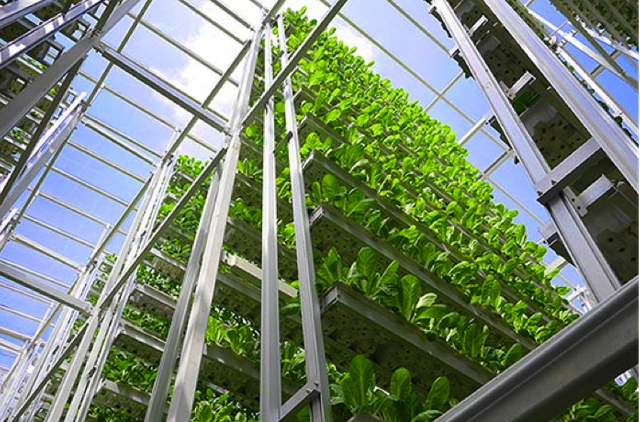

Hello guys !!! Today I write about vertical farms, a subject that despite sounding futuristic, is already a reality in different countries and becomes important as the population increases and the arable area decreases, we will start defining the concept and then evaluate its advantages and disadvantages.
What are vertical farms?
Basically they are buildings whose purpose is to be food factories. Comparing to a traditional farm, vertical farms can produce vegetables and in some cases even meat, producing birds and fish, the extensive traditional growing surface is replaced by a vertical structure up to several floors, soil by substrates or water, Through techniques such as hydroponics, the place of sunlight is taken by electric lighting and the climate is controlled by air conditioning, thus achieving a controlled environment with harvest throughout the year where it does not require the use of pesticides and others Chemical and that, being in the urban zone, produces food near where they will be consumed, with the corresponding saving of fuels and pollutants. The vertical farm gives rise to a new specialty: The vertical farmer, who must have a high degree of specialty in the technologies involved. The team in charge of building and maintaining the vertical farm will be multidisciplinary and may consist of: agronomists, architects, biologists, economists, architects, engineers and town planners.
Background
Possibly the oldest reference we have of plants integrated to the architecture of the buildings are the hanging gardens of Babylon in century VI A.C.
As far as animal farms, around 1900, one has the antecedent of a small farm installed in the roof of an apartment building in New York.
In 1979, the physicist Cesare Marchetti published a report where he conceptually managed the planet's ability to contain and feed people.
As an antecedent of a controlled environment, we have Biosphere 2 an artificial closed ecosystem for research, built in Oracle Arizona.
It was until 1999 when Dickson Despommier set out on the task of designing a viable vertical farm, his work received a great boost in 2007 with the publication of the article "Skyfarming" in the New York Magazine interested to scientists and companies of the world in the theme. Dickson Despommier is a biologist and professor of environmental sciences and microbiology at Columbia University. It is currently developing the concept and is related to agencies that are already bringing vertical farms into practice, both in cooperation with Columbia University and independently.
Why vertical farms?
By 2050 to feed the world population through traditional agriculture would require a cultivable area equal to the size of Brazil, this without considering that besides not having a similar surface, the surface of arable land is reducing every day.
The space will be scarce, so as in the housing issue, in food, the solution may be to build up taking maximum advantage of the surface.
For that year, 80% of the population will live in urban areas and the fact of producing the foods practically where they will be consumed brings additional benefits as to avoid the degradation of the same ones during long transfers and to reduce the pollution that this transport implies.
What then will happen to arable land and farmers?
Cropland can be reforested with trees, reducing global warming, regulating the climate and preventing soil erosion.
As far as the farmers, these will be able to be in charge of the reforestation and care of the trees.
Advantages of vertical farms
Controlled environment
All types of vegetables can be harvested throughout the year and harvest damages are eliminated due to natural causes such as drought, flood, hurricanes, pests, etc.
Efficiency
What in this case could be translated as the ability to feed a large number of people per square meter of crop, using resources such as water and energy to a minimum and even in some projects to generate it.
Quality of food
By reducing the use of pesticides and fertilizers, as well as the time it takes to get from the place of production to the diner, food is healthier and fresher.
Reverse global warming
That is, not only reduces the carbon footprint generated, also reverses the process as the extensive land devoted to cultivation, can now be reforested with trees. It also helps to reduce the time and distance of travel with the respective fuel savings and pollution.
Reuse of leftovers
The organic remains of the crops can be reused as fertilizer and food from animals that in some prototypes form part of the same farm.
Regeneration of ecosystems
In addition to the beneficial effects with respect to global warming, soil erosion and water pollution are avoided.
Disadvantages
We can not fail to consider the disadvantages, which as we will see are not many but can be the difference between making a project reality or simply leaving it on paper.
Energy costs
This could be the main drawback, of not making the vertical farm self-sustaining, the amount of energy to provide light to the plants of lower levels or to make it rotate, as well as the energy for the rest of the functions of the building can be very high.
Cost of construction
The construction of the building itself and the equipment with the necessary technology is undoubtedly enough costs.
Cost of land
Although the idea is to build upwards, if a minimum of land is required and thinking about meeting the objective of producing the food near where it will be consumed, it becomes necessary to think of a land in the downtown area of the city , Where spaces are generally scarce and expensive. This point may not be transcendent, as a large area of cultivated land is being changed by a small urban plot, so the difference in land investment may be minimal.
great, i would really like to make vertical farm buildings here in Argentina, i mean, 18 floors of farms in vertical mode, i dream about it haha, thanks and best regards
Downvoting a post can decrease pending rewards and make it less visible. Common reasons:
Submit
Hi Ciruelosmf , thank you very much, the cost is not so high, it is a very big business reality, very profitable, healthy and natural. Kisses Argentina.
Downvoting a post can decrease pending rewards and make it less visible. Common reasons:
Submit
great topic / great overview
Downvoting a post can decrease pending rewards and make it less visible. Common reasons:
Submit
Thnks so much!!!
Downvoting a post can decrease pending rewards and make it less visible. Common reasons:
Submit
Downvoting a post can decrease pending rewards and make it less visible. Common reasons:
Submit